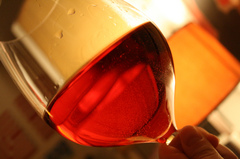How to pick a good rosé wine

Good rosé wine is crisp and refreshing.
Photo by Flickr user theogeo
Good rosé wine is crisp and refreshing: relaxing and invigorating at the same time, with fresh aromas of fruit and spices and able to cut through the summer heat like a fresh squeeze of lemon on a fine piece of fish.
Here's a short and sweet guide to how rosés are made, and how to pick a good one.
We've certainly seen a lot of interest in these wines, although they have a long and ignominious history in the U.S.-- blush wines in a box, semi-dry bulk wines from the Mediterranean ... Many who have ventured to the south of France have enjoyed at least the carafe-quality versions of the local dry pinks, but many American wine drinkers have been exposed only to the less-than-spectacular versions produced by the tanker truck load in California. I won't name any names, but who can forget the ubiquitous box at the family holiday?
What is rosé? Rosé wine is pink-- it can be dry, sweet or anywhere in between. It can also be bubbly, like Champagne.
What makes rosé a great summer wine? Good rosé is crisp, mouthwateringly so. It sets off the rich, smoky flavors of grilled foods, and plays nicely with light fare like fresh veggies, fresh cheeses, and salads.
How is rosé made? Rosé can be made in one of three ways: 1. Direct to Press: made from red-skinned grapes, which almost always have clear juice. The grapes are harvested and crushed, but the pulp and skins remain in contact with the juice for a short time, absorbing some color from the skins (think of a teabag, leaching color into the hot water). Red wine is made this way, and usually the skins stay in the juice for 2 weeks or more to extract the full color. Rosé attains its characteristic pink hue in as little as a few hours, but usually 3-4 days is more typical. The is the most common way of producing high-quality rosé.
2. Saignée: in this case the rosé is a byproduct of red wine production--during the maceration of the skins in the juice, some pinkish half-fermented wine is drawn off. The purpose is to concentrate the remaining pulp in the vat, with the hopes of producing a more concentrated and tannic red wine.
3. Blending: red wine and white are mixed to get the desired flavors and colors. This is the least common way of producing high-quality rosé, except in Champagne.
Where are the best rosés made? It is my opinion that in general, the best quality and variety of rosé wines are made in the south of France. There are notable exceptions, with high-quality, well-balanced wines being made in every wine region in the world. But in general, look for these names on the label, in order of increasing quality (and usually price, as well):
Coteaux du Languedoc: inexpensive wines, almost always less than $20, but usually very good value. Can be made from a wide variety of grapes, but usually Grenache, Cinsault and Syrah are used. The styles are widely varied. Watch out for really high alcohol content (more than 14 percent especially) as these wines can be too big for summer drinking.
Tavel and Lirac: near Chateauneuf-du-Pape, on the east side of the Rhone river. These Grenache dominated wines are big, with a rich red-purple color like fresh raspberry juice. The flavors are powerful, too, and they are the closest to red wines in style. Expect to pay $20 or more for most of these.
Bandol and Cassis: Provence, right on the sea. The most noble of French rosés, and the most expensive (excepting those from Champagne). Usually made from some blend of Cinsault and Mourvedre grapes, dry, with a careful balance between body, acidity, and fruit. Maybe the best of all rosés at offering umami, or savoriness mixed with freshness. These wines are pricier, $25-$40.
Other regions of Interest Anyone who has been in our decidedly French-focused wine department will not be surprised that most of this list is comprised of French wine regions:
Loire: Pinot Noir and Gamay-based wines, sleeker, with charming berry fruit and less body than their southern cousins. $15-$25.
Burgundy: Pinot Noir-based wines. Cherryish, very food-friendly, more expensive. $25 and up.
Spain: for inexpensive wines, look to Campo de Borja (rustic, bold, grenache-based rosés that take no prisoners) or Rioja (sleek, understated, mild wines made from Tempranillo and Garnacha).
Australia: Aussie rosés tend to be bigger than their European cousins, so watch out for oversized wines that fail to deliver on freshness.
What should I buy? If you've read this article, think about what sounds good for you, then ask the folks at the wine shop.
Matt Morgan blogs on food and wine for AnnArbor.com. He is co-owner of Morgan & York Fine Wines and Specialty Foods in Ann Arbor, and drinks a lot of rosé.

